(45,109 statute miles ; 72,595 km)
Our last update was compiled in Langkawi, Malaysia but only covered the three month voyage from Darwin through Indonesia to the Malay Peninsula. It makes sense therefore to resume our saga in Singapore, whilst trying to avoid repeating some of the material on Malaysia that appeared in the last edition of Latest News.
The city state of Singapore is one of our favourite places for short stays . We arrived by sea for our 7th visit, all the others being 3 day stopovers on flights to and from NZ and Australia. This time we were there for two whole weeks which flew by as we basked in the availability of every conceivable product, after three months of deprivation in theIndonesian archipelago. Our stay coincided with the Hindu Deepvali festivities, so the streets of Little India were awash with vividly coloured decorations.
Sailing northwest out of Singapore into the Malacca Strait was a frenetic experience, threading our way through what seemed like half the world's commercial shipping, followed by a plethora of badly marked, very long Malaysian fishermen's nets strewn across our path. Conditions were not ideal either, with strong headwinds and counter currents.
So, after three hard days of sailing we were only too pleased to pull into the marina at Port Dickson where the Sail Malaysia Rally had its first event. We have mentioned before that we are not 'Rally Sailors' but here as in Indonesia there are special advantages, not the least of which is security, as the Malacca Strait has a reputation for piracy. The other good things, aside from the social life, are the excellent inland coach tours, complete with local guides who explained all aspects of the countryside, as well as social and political structure lucidly in perfect English. Here Di is being inculcated in the art of batik where a boundary of molten wax is applied to the fabric before colouring-in to create a dramatic result.
Our next port of call was Lumut, a naval town not far from the resort island of Pangkor which we reached after a turbulent night passage of vicious winds and dramatic lightening storms. There, the rally members which by then had probably dwindled to about 30 boats, received what could only be described as a right royal welcome. We should explain that the Kingdom of Malaysia has a ruler for each of the thirteen provinces. They take turns at being the 'numero uno', national King or Sultan on a 5 year term, rotating basis. This king of Perak is third in line, so if he hangs on for a further 12 years he'll make the top slot. We had wondered how such an event would work out but he turned out to be a great guy, very informal and full of genuine interest. He came to our gala dinner that night (yes, yet another free bash) and even sang a couple of songs for us (Liz and Phil take note).

Further up the coast is the island of Penang, the old colonial capital and regional centre of trade, before the emergence of Singapore. It is a charming old town of varied architectural heritage, interwoven with historical significance. We saw some of it from a tri-shaw, accompanied by an excellent local guide with a forte for salacious historical gossip. The painstakingly restored, Georgetown mansion that Cheong Fatt Tze built in the mid-19th century is reputed to be the most outstanding of its type outside China with its 38 flamboyant rooms, 5 courtyards, 7 staircases and 220 windows. He had an international reputation for trade and diplomacy, being recognised as one of China's last Mandarins and first Capitalists. He died in 1916.
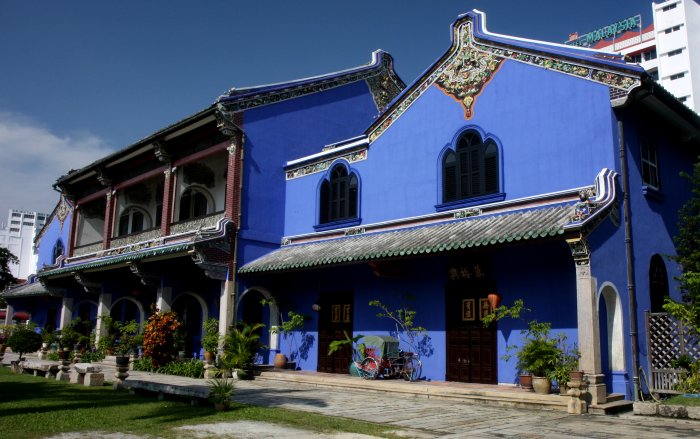
The hills just behind the city of Penang are the home to an enormous complex of Buddhist temples which were begun in 1846 and are still being extended. One of the latest, nearing completion, is a very impressive, 120ft high bronze statue housed within a huge twelve pillared granite pagoda. It was easy to spend a whole afternoon exploring many of the temples and climbing some of the high towers to gain impressive views out over the town and across the strait to the Malay mainland.
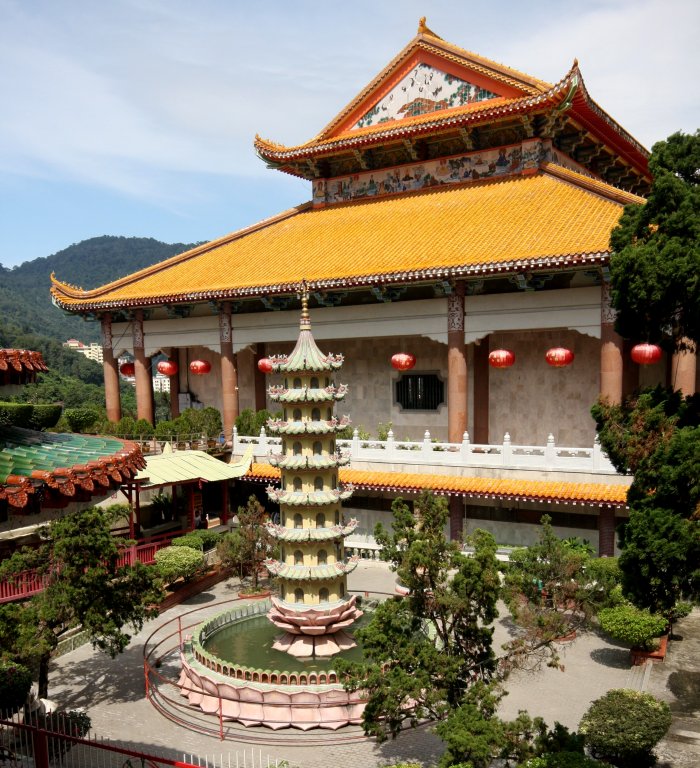
We have made a couple of trips to Kuala Lumpur, the bustling capital which has somewhat of a reputation as a shopping mecca. Fortunately we are immune to almost all such temptations, as after living on a boat for nine years, we have little or no space for further clutter of any type. The original settlement was named by tin miners after the confluence of two muddy streams. The streams are still there but are no longer surrounded by jungle but a very modern city of towers, high rise buildings and sophisticated infrastructure including an extensive monorail network.
Malaysia, like Singapore has a thriving economy based on mineral oil, palm oil and rubber. The considerable wealth generated seems to have been applied widely to infrastructure projects and education, under the long tutelage of Prime Minister, Dr Mahathir Mohammed. It is a predominantly Muslim country where religion and racial origin is reputed to be a passport to many opportunities in education and employment. This has led to considerable inter-racial strife over the years and was behind the recent government reversals in the March'08 elections.

The Telecom tower above was the place where we took the elevated views over the city that appeared in the last Latest News. KL is a pleasant city to stroll around on foot, provided that the sky is overcast or there is a good breeze. Otherwise it is very hot, the least exercise bringing on an excess perspiration and a dash for any air conditioned building. Below is the Sultan Abdul Samad Building, one of many impressive Colonial era structures around the Merdeka Square.
Mosques and temples abound all around the city and most seem to be ever active with local worshipers and tourists. The fine example of a Chinese temple below we stumbled across in a city centre side street.
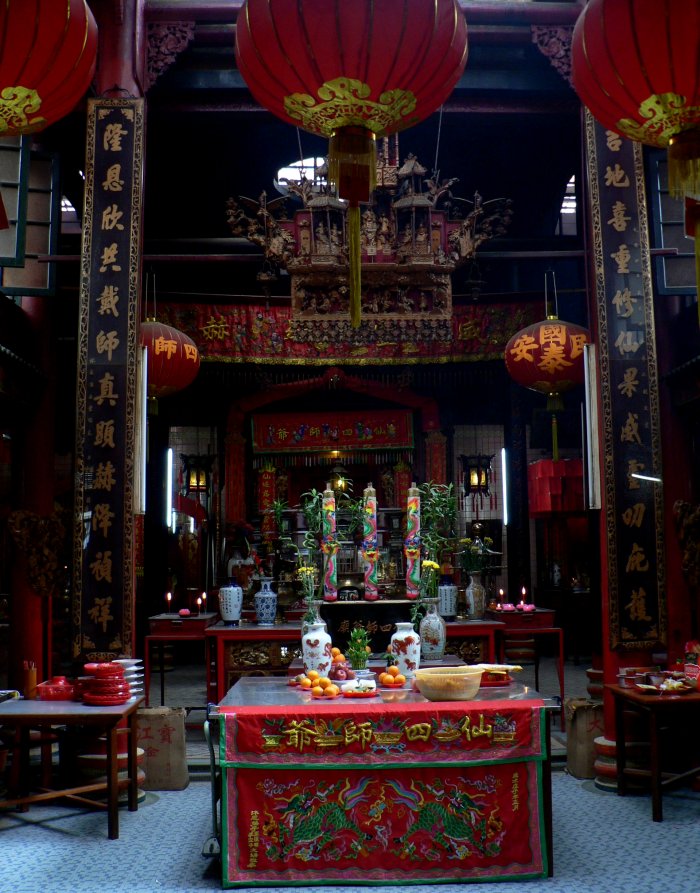
Chinese temple hidden away in the side streets of KL
A good day sail north of Penang is the charming Malaysian tourist island of Langkawi. For us it was the first welcome departure from the boring flat landscape of the Malacca Strait and a place where at last we could anchor in quiet bays or under towering cliffs. Also the waters were looking less brown and refuse laden. It has a further attraction much appreciated by a typical cruising yachtsman, in that it is the only duty free area in the country. It took over this role from Penang, maybe because Langkawi was the birthplace and home of the last, long serving prime minister, Dr Mahathir Mohammed. The main town of Kuah has a definite Muslim identity which is somewhat at odds with the dozens of prominent alcoholic drink outlets.
Langkawi is an island of high mountains, streams, waterfalls and forests which are home to innumerable posses of monkeys. The birdlife also includes impressive large brown eagles which we often observed cruising over coastal waters. They have been honoured by this impressive masterpiece of structural art that has given name to Eagle Point beside the island's major ferry terminal.
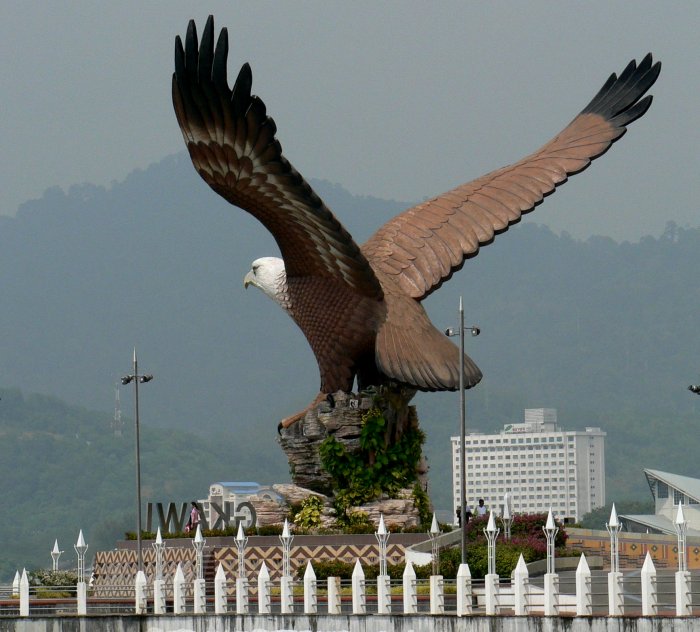
Our first stay on the island coincided with the biannual Langkawi International Aviation and Marine exhibition (LIMA 07). This is a predominantly defence orientated show which has become the Farnborough of SE Asia. Thanks to an ex-Australian Navy friend we managed to acquire a couple of trade-day tickets which gave Dave an excellent chance to catch up on developments whilst he has been away cruising. Di's patience was rewarded by some impressive flying displays and a chance to see the young man below, Malaysia's first astronaut who flew on a Russian mission.
Sadly the air show coincided with the first period of cloudy, wet weather we had seen for some weeks. Many of the international teams called off their flying displays on the day we were there but thankfully the RAF's Red Arrows flew a crowd thrilling programme with lots of good photo opportunities.

Just a few miles north of Langkawi is the border with Thailand whose western coastline is scattered with magical offshore islands set in waters which grow rapidly clearer as one sails the 130nm north toward Phuket and on to Myanmar (Burma) around the same distance again. Almost all these islands are formed from karst limestone and rise precipitously from waters around 50m deep. Finding a good sheltered anchorage is not always easy but when you do it is invariably in dramatic surroundings, close to cliffs rich with strangely formed stalactites. One such famous spot is within a huge bay surrounded by 120m cliffs at the Island of Phi Phi Lee. This was made famous as the site where the 1999 film, The Beach was filmed. As a result it is now overrun by thousands of backpacker visitors every day, arriving in small groups of around four or five on a longtail or by tripper boats and ferries transporting hundreds. They normally stay only an hour or so for a quick snorkel but create mayhem in the restricted anchoring area off the reef. We took this picture from The Beach early in the morning before the circus began.

Just 5nm further north is another iconic tourist island, Phi Phi Don which some say is the most beautiful island in the world. Not a claim that we would in any way support. It is formed by two huge rock masses joined by a narrow beach on which is sited a crowded backpacker haven for several thousand revelers. Not really our sort of place but there are two good anchorages and wandering ashore amongst stalls, restaurants and bars, observing the mainly very young visitors is something you have to do. The whole place was the site of enormous devastation and loss of life when the tsunami struck on Boxing Day morning 2004.

Longtails and ferries on the backpacker island of Phi Phi Don
Our destination for the festive season was Phuket Island, a crowded tourist haunt,but one with some lovely quiet, if somewhat crowded anchorages. Nai Harn, below was one of our favourites with a huge beach and many good restaurants. We had discovered that not only was Thai food generally some of the best we have come across so far on our voyage but was also so cheap as to render buying and cooking aboard unjustifiable. We enjoyed a magnificent Christmas there, surrounded by dozens of close sailing friends. We also managing to visit other cruising friends from the season ahead of us, who had bought properties there.

Nai Harn Bay on the sheltered SW corner of Thailand's Phuket Island
This western shore of the island is indented with many small bays, each with a large resort or apartment complexes. All would have made superb anchorages but for the mindless jet-ski riders by day and the music emanating from bars at night. Still, we had just had eight months of relatively placid anchorages with nowhere to go and nothing to do so couldn't really complain.
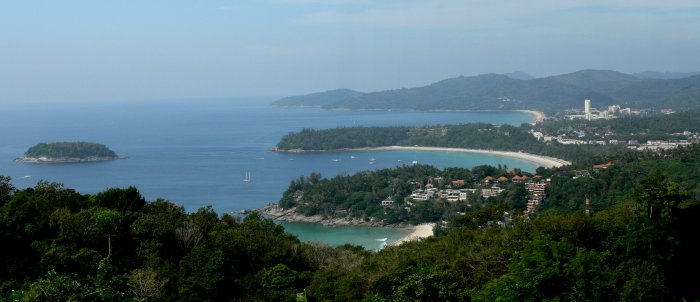
Getting around the place by open backed bus was relatively easy and there were also cars and small motor cycles for hire, not to mention the plethora of tut tut taxis. Car hire was usually an informal affair with no mention of licence, insurance or paperwork. Motor bikes we kept well clear of as the accident rate, particularly amongst tourists is staggeringly high. Driving standards are erratic to say the least! Vehicles pass and cut across you at a great rate and bikes often carrying whole families of five or more emerge from side roads just ahead of you. The main town centre has hundreds of tourist gift shops and not much else to interest us other than this great fruit and veg market.
On the east side of Phuket is a huge bay abutting the mainland, the northern part of which is known as Phang Nga. This is a picture book scattering of rocks and islands, all high and sheer sided, set in shallow waters often less than 10m deep. Again composed of karst limestone, they are mainly undercut with many caves and stalactites. It is a vast playground for cruisers and trip boats alike. Here we are motoring in light conditions on the 2hr trip from the NE of Phuket Island.
Below is a typical example of undercutting which makes wonderful shade when we launch Yellow Peril, our two person inflatable canoe to explore the crevices and caves that abound on every island. Many of the caves lead into a Hong which is the Thai word for room, an open to the sky, flooded cave often hundreds of metres long within the huge mass of rock.
One of our most magical anchorages was beneath on enormous pillar of rock at the western end of Koh Yang (Koh being the Thai for island) with our own deserted beach 100m away. Fantastic scenery to chill out amongst after the hurly-burly of tourism in Phuket.
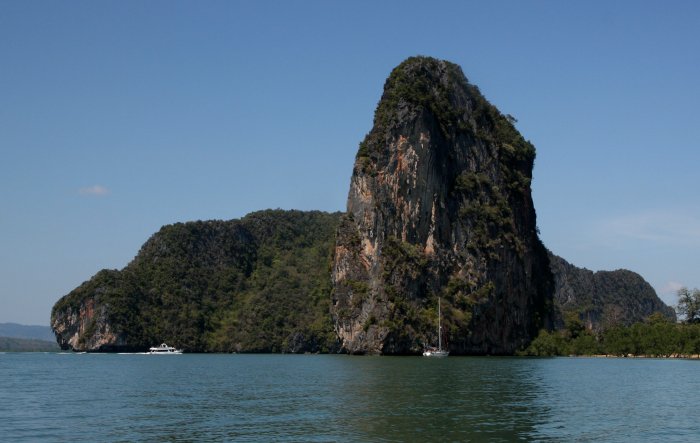
No more than a mile to the east of our idyllic anchorage is Koh Ping Kan which was featured in the James Bond film, Man With a Golden Gun. Immediately behind the jetty on the left of the picture below you can just discern the pillar of rock seen in the film housing a laser beam which now bears the name James Bond Island and which appears as the homepage picture in this, version 28 of our voyage updates. We went over to the island in our tender and were confronted by hundreds of tourist trippers and ranks of pushy stall holders offering all the usual rubbish.
We did get to explore several Hongs in our canoe, often negotiating narrow tunnels up to 100m long, using a high power lamp with an external 12v sealed lead-acid batteries to find our way in total darkness. Here is Di in the front seat as we emerge from one of the entrances.
Amongst the most distinctive places we visited in Phang Nga Bay was the fishing village of Koh Pan Yi, known locally as the Muslim Village. Here over 2500 people live in a compact settlement built entirely on stilts over a mudbank to the south of a large rock. In this picture it appears small and pointed but as is invariably the case in this region, rocky outcrops are tall, shear sided, thin and often very long. This one is probably 75m wide at its base and 800m long. Another similar, uninhabited rock called Koh Phetra that we anchored off was around 100m wide, 150m tall and 3km long, looking just like a huge saw blade.
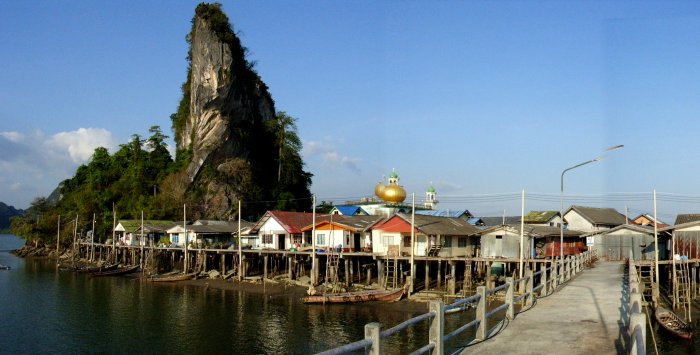
On the western side of the Phuket peninsula are a number of large hotels and tourist settlements. By far the most notorious is Patong, a veritable den of iniquity which we first encountered when we anchored off for the New Year festivities. Again, apart from a large Carrefour supermarket, there was little there for us, aside from being another one of those places you should at least experience for an instant and shudder over the memory of for ever more.
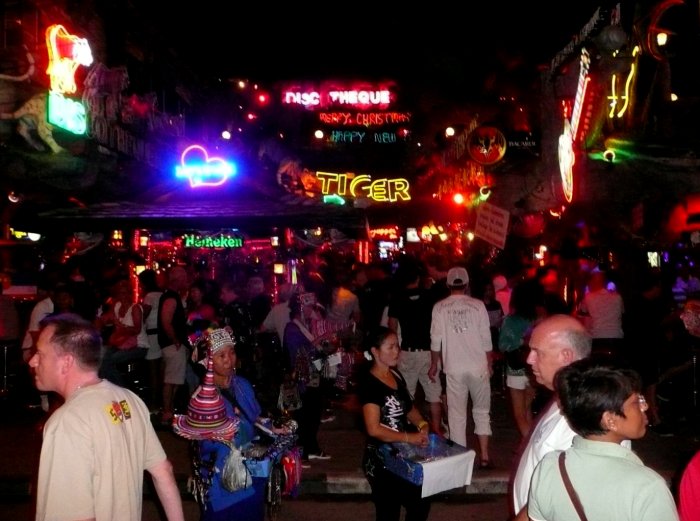
To negotiate the streets of Patong one needs to be super tolerant of a continual bombardment of offers of land tours, longtail trips, tut tuts (taxis), bespoke tailors, kick-boxing tournaments, masseurs and every other conceivable holiday diversion. The sign below probably sums up the place better than any words we can conjure.
Amongst all this, on the edge of town is a renowned Vegas style show called the Simon Cabaret. Along with about twenty cruising friends we had a rollicking evening of song performed by an all men cast in sumptuous costumes, on a stage of ever changing intricate sets.

After the show, the cast gather beside the theatre for a photocall. A 100 Baht note (£1.30) buys you the opportunity to pose beside your favourite beau for a memorable picture. Getting closer-up makes it even more difficult to believe their gender but we can assure that it really is an all male show!

Several times we have mentioned the longtail craft that form the backbone of the Thai short haul tourist trade. These converted local boats are powered by a car engine mounted like an outboard motor, atop a long pole over the transom. In seafarers they invoke a shudder with their high centre of gravity, highly unstable turning characteristics and raw seawater cooling. However, in their favour, they are cheap to acquire and run as well as not requiring a hole in the hull with all the sealing requirement that this entails.

As in Indonesia, fishing is a major economic activity in the waters up the west side of the Malay Peninsula. Almost everywhere we sail there is a need for constant vigilance as pot and net buoys are often less than 100m apart with fishing boats of all shapes and sizes, including big trawlers dashing around everywhere. As a result, we never sail close inshore at night unless we really have to. Here below are a colourful bevy of boats from the same stable, rafted up for the night in sheltered waters off the northern Similan Islands.

The Similans and Surins are island groups stretching 100nm to the north west as far as the Thai border with Myanmar (Burma). Cautious navigation is the order of the day there as straying across the line, especially after the recent crackdown by the ruling generals could precipitate a diplomatic incident.
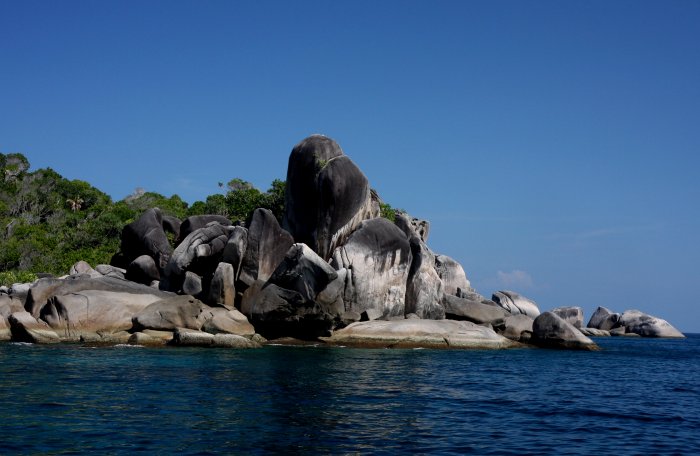
These are attractive granite islands of rocky outcrops with large boulders and small sandy beaches. For us however, the main attraction is beneath the waves where we can snorkel and dive in 31°C water with 50m visibility and a plethora of marine species. It is the sort of place we settle into for two or three weeks until we run short of essential supplies.

Diving in remote places is only possible when you have an independent source of compressed air. Our petrol driven Bauer Junior travels in two parts in a locker below and is only brought out when we can justify the effort required by the 40min set-up and tear-down time. It is not so much the time as the awkward weight of the unit which, even in two bits, is a handful in a fairly confined space. Worst of all is the noise the thing makes which not only requires us to wear ear defenders but also attracts other divers with empty tanks which only serves to prolong the agony.

Where to next:-
We have just been back to the UK for six weeks for Di's Mum's 90th birthday and of course to see all the other family & friends and especially to catch up on the progress of our three lovely grandsons. Some pictures from this trip appear in the Latest News page, accessible from the Homepage.
Our return to Amoenitas in Langkawi, Malaysia will be but a short one as we fly off to New Zealand for two months early in May to catch up with family and friends there. We left there for the last time in June of 2005 and really do miss the wonders of the scenery and life on the farm. We also plan to do some land travel in Cambodia, Laos, Vietnam and China, as well as some walking and climbing in the Himalayas. How we will fit it all in we don't know, so we may just have to hang around SE Asia for a few more years just to do the land bit.
Meanwhile, there's also a lot of sailing to be done around the mass of islands to the north and we hope to get a visa from India to visit the Andaman Islands. The trip across the Indian Ocean and up the Red Sea to the Med via Suez will have to wait until we really feel we are 'cruised out'. and can face Europe in the winter again. Fortunately no signs of that yet but the appearance of grandchildren has introduced another factor into the equation. Still, it is much easier for us to return to Europe from here and of course for visitors to come to us.